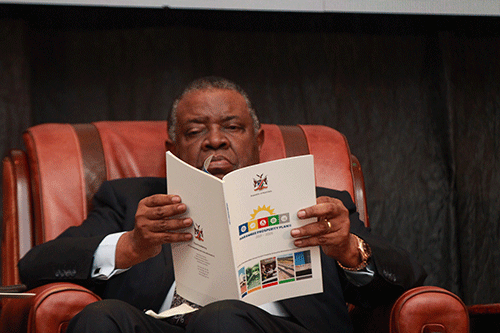President Hage Geingob’s administration has outlined an ambitious plan to lure investments worth N$27 billion, with the potential of creating 24 000 jobs in the coming four years.
Rolling out the construction of a new a desalination plant in the Erongo region, optimising the operation of the Walvis Bay Container Terminal and establishing an economic free zone are some of the key projects government will be banking on to provide a significant boost to the economy, which has been ravaged by the virulent Covid-19 pandemic.
“This is a period of great opportunity and we thus invite investors to partner with the government, in the construct and delivery of these transformative initiatives encapsulated in the plan, which have the potential to transform our country for generations to come.
Our objective is to unlock targeted projects worth approximately N$27 billion,” Geingob told a well-attended audience at State House, which included Cabinet ministers and journalists, while launching the second installment of the Harambee Prosperity Plan.
Geingob announced government will concentrate on expanding local power generation capacity by 250 megawatts.
Government is also exploring the development of green ammonia. Green ammonia uses renewable energy instead of natural gas or coal for producing hydrogen. Therefore, with green ammonia production, renewable energy can be stored and reused for power generation at consumption points.
“Given our world class renewable energy resources, Namibia will develop a national strategy for developing green hydrogen and ammonia. As we pursue this strategy, we have the opportunity to become the first country in Africa to achieve carbon neutrality and utilise the African Continental Free Trade Area (AfCFTA) to export clean energy to our neighbours,” he said. The HPPII retains the five pillars as enshrined in HPPI, including effective governance, economic advancement, social progression, infrastructure development and international relations and cooperation.
On economic advancement, presidential economic advisor James Mnyupe announced as part of the HPPII economic recovery effort, the government will commit to invest N$400 million through the project preparation fund and other mechanisms to unlock projects with a commercial value above N$27.2 billion.
“This will be achieved by leveraging private sector capital and knowhow through a mixture of public-private partnerships and other procurement methods,” Mnyupe noted. In fact, the Namibia Investment Promotion and Development Board, which falls under the Presidency, and established last year to improve the country’s investment competitiveness, was allocated N$125 million according to budget documents.
Housing
The Geingob administration has also set its sights on delivering 20 000 housing units and servicing 24 000 erven countrywide by the end of the HPP II in 2025 to address the housing crisis in the country. Namibia currently has a housing backlog of 300 000 units.
In addition, HPPII wants to see 84 townships proclaimed with economic viability by the end of 2025.
The contentious Rent Control Board is expected to be operationalised following its promulgation at the end of this year.
The plan further promised to allocate completed mass housing units at Swakopmund (505 units), Otjomuise Extension 10, Windhoek (362) and Opuwo (24), and all other unallocated mass houses by 2022.
Key targets of HPPI, which ran between 2016-2020, included the construction of 20 000 houses, servicing 26 000 plots, and erecting 50 000 toilets by 2020. However, these targets were missed after the government only managed to construct around 15 000 houses.
Geingob yesterday emphasised that HPPII remains a targeted impact plan, consisting of prioritised short to medium-term goals and strategic actions to accelerate national development towards Vision 2030 and prosperity for all. The HPPI managed to achieve an execution rate of 74%. Geingob said valuable lessons have been learned in the process.
“I believe strongly that history is the best teacher and every resilient nation must learn from its past, its lived experiences, which include victories and setbacks, in order to face the future with renewed hope and confidence,” said Geingob.
“It is why, based on lessons learned from the implementation of the first Harambee Prosperity Plan, we have identified throughout the pillars, the need for improved focus and coordination; deeper collaboration and partnerships; and a collective sense of urgency to deliver on our desired outcomes.”
Geingob further said the HPPII has been re-engineered to strengthen effective governance architecture to better respond to the new socio-economic challenges that have been occasioned by Covid-19. Prime Minister Saara Kuugongelwa-Amadhila was quick to clarify the HPPII is complementary to government’s already existing national development plans.
‘People-centred’
On social progression, presidential advisor on youth matters Daisry Mathias explained that this pillar takes a people-centered approach to development that aims to ensure improved quality of life for all Namibians, especially the most vulnerable members of society.
“Meaningful progress in arresting poverty, income, and wealth inequalities has been made. However, these gains risk being reversed by several intervening independent variables. The desired outcome for this pillar is to provide the basic amenities for a dignified life, social mobility, and human development,” she stressed.
Under this pillar, government aims for zero deaths from hunger poverty, improved access to healthcare as well as improved access to quality education and sport.
On effective governance, presidential advisor Inge Zaamwani-Kamwi explained this pillar is geared towards entrenching governance measures that aim to improve accountability and transparency, strengthen the national anti-corruption mechanisms, improve performance and service delivery, and enhance citizen participation, security and the rule of law. The pillar comprises five goals and 23 activities.
She said it was vital that these goals focus not only on government systems but also to enhance collaboration between stakeholders including the private sector, developing partners, and the citizenry.
“Namibia’s economic, social and environmental future rests on government’s ability to place people at the centre of decision-making and development,” Zaamwani-Kamwi noted.
- anakale@nepc.com.na


